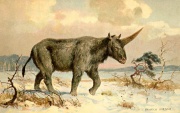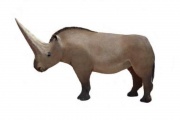Elasmotherium
From Textus Receptus
Elasmotherium ("Thin Plate Beast") was a genus of giant rhinoceros endemic to Asia during the Pliocene through Pleistocene living from 3.6 mya—126,000 existing for approximately Template:Mya.<ref>PaleoBiology Database: Elasmotherium, basic info</ref>
Contents |
Taxonomy
Elasmotherium which stood, on average, 2.7 metres (8.9 ft) high and 6 metres (20 ft) long, with a single two-meter-long horn in the forehead. The animal may have weighed up to 7 tonnes (7.7 short tons).Its legs were longer than those of other rhinos and were designed for galloping, giving it a horse-like gait. It was probably a fast runner, in spite of its size. Its teeth were similar to those of horses, and it probably grazed low herbs.
The genus appeared during the Late Pliocene in Central Asia, being derived from the genus Sinotherium. E. inexpectatum and E. peii inhabited Eastern China during the Upper Pliocene to Early Pleistocene. They disappeared approximately 1.6 Ma. The earliest records of Elasmotherium species in Russia are known from the Upper Pliocene assemblages near the Black Sea. E. caucasicum was widely distributed in this area between 1.1 Ma and 0.8 Ma. The more advanced (and largest member of the genus) E. sibiricum appeared in the Middle Pleistocene. It occupied all of the southwestern part of Russia, reaching eastward to western Siberia, then south into Ukraine and Moldova. Elasmotherians persisted in eastern Europe until the end of the Middle Pleistocene.
Description and paleobiology

Morphological peculiarities of elasmotherians have generated two main hypotheses concerning their appearance and the character of their habitat. The first, most widely accepted viewTemplate:Fact which was also described above, portrays them as large woolly animals with a large forehead horn that thrived on an open steppe. Fossils of the horn, however, have not been found. The other viewTemplate:Fact assigns elasmotherians to riparian biotopes. It is probable that elasmotherians dwelt in both riparian and steppe biotopeTemplate:Fact. The riparian biotope is suggested by dental and skull morphology. The combination of such characteristics as the absence of canines and strongly developed lateral processes of the atlas implies lateral movements of the head, presumably for grasping grass. The hypsodont dentition indicates presence of mineral grains in the food. Such food could be obtained by pulling out dense plants from the moist soil. These conditions are typical for riparian biotopes. On the other hand, a steppe biotope is indicated by their rather long and slender limbs, which would have served well for creatures grazing over vast areas.
Possible historical witnesses
It is believed that Elasmotherium died out in prehistoric times. However, according to science writer and cryptozoologist Willy Ley, the animal may have survived long enough to be remembered in the legends of the Evenk people of Russia as a huge black bull with a single horn in the forehead.
There is also a testimony by the medieval traveller Ibn Fadlan which has been interpreted by some to indicate that Elasmotherium may have survived into historical times.
Ibn Fadlan's account states:Template:Blockquote Template:Blockquote
Some have argued that the survival of Elasmotherium into historical times may be the source of the unicorn myth, as the animal's description could be argued to fit with the Persian karkadann unicorn, and the Chinese zhi unicorn.
References
Cite journal | author = Noskova, N.G. | title = Elasmotherians - evolution, distribution and ecology | journal = The World of Elephants - International Congress, Rome 2001 | year = 2001 | url =http://www.sovraintendenzaroma.it/content/download/4758/62254/file/126_128.pdf

